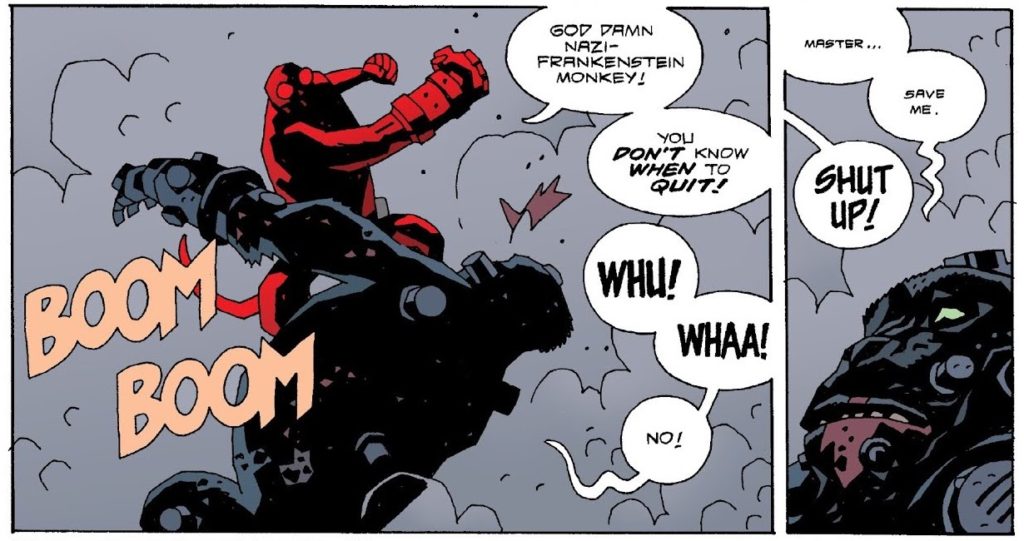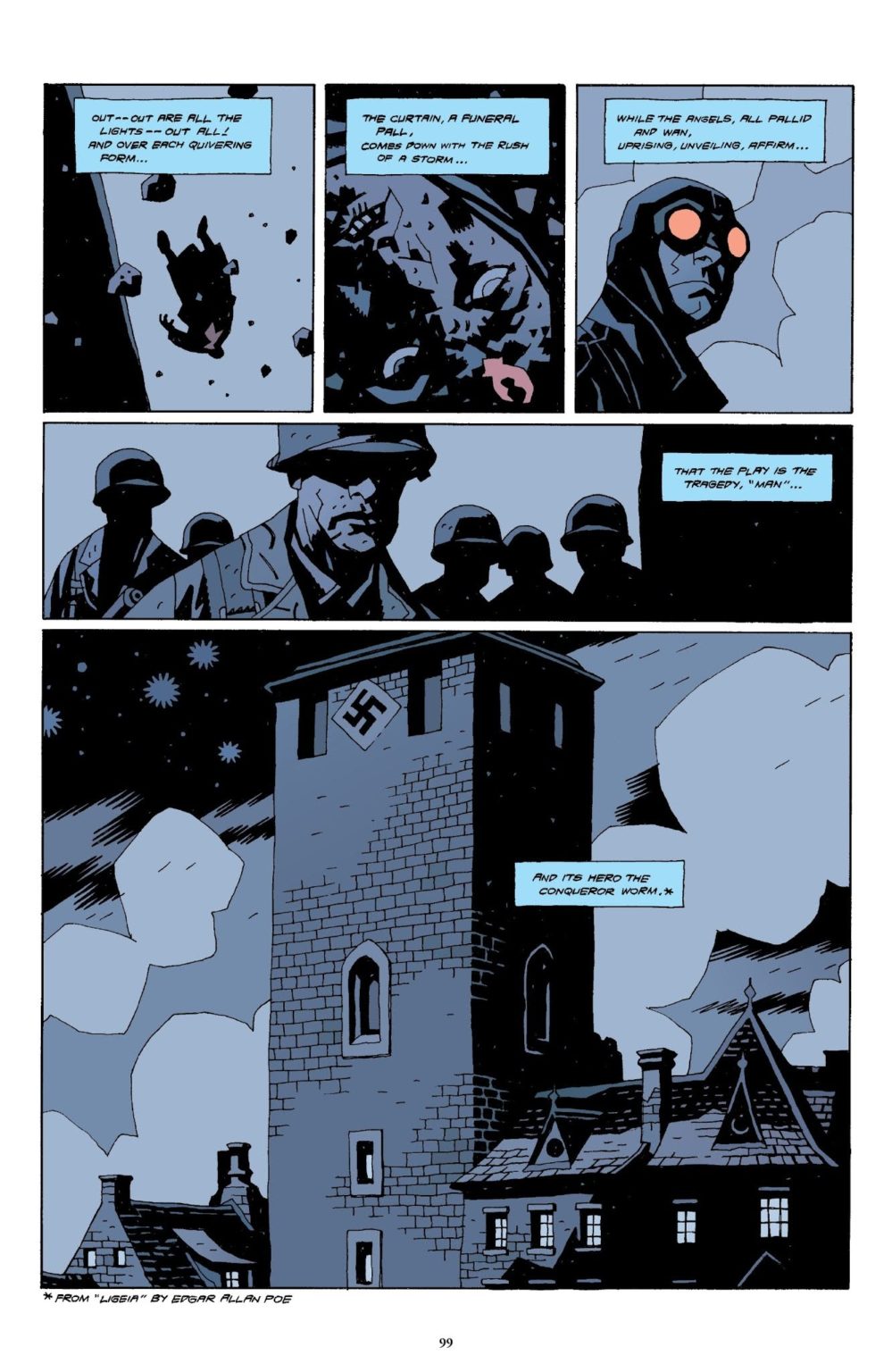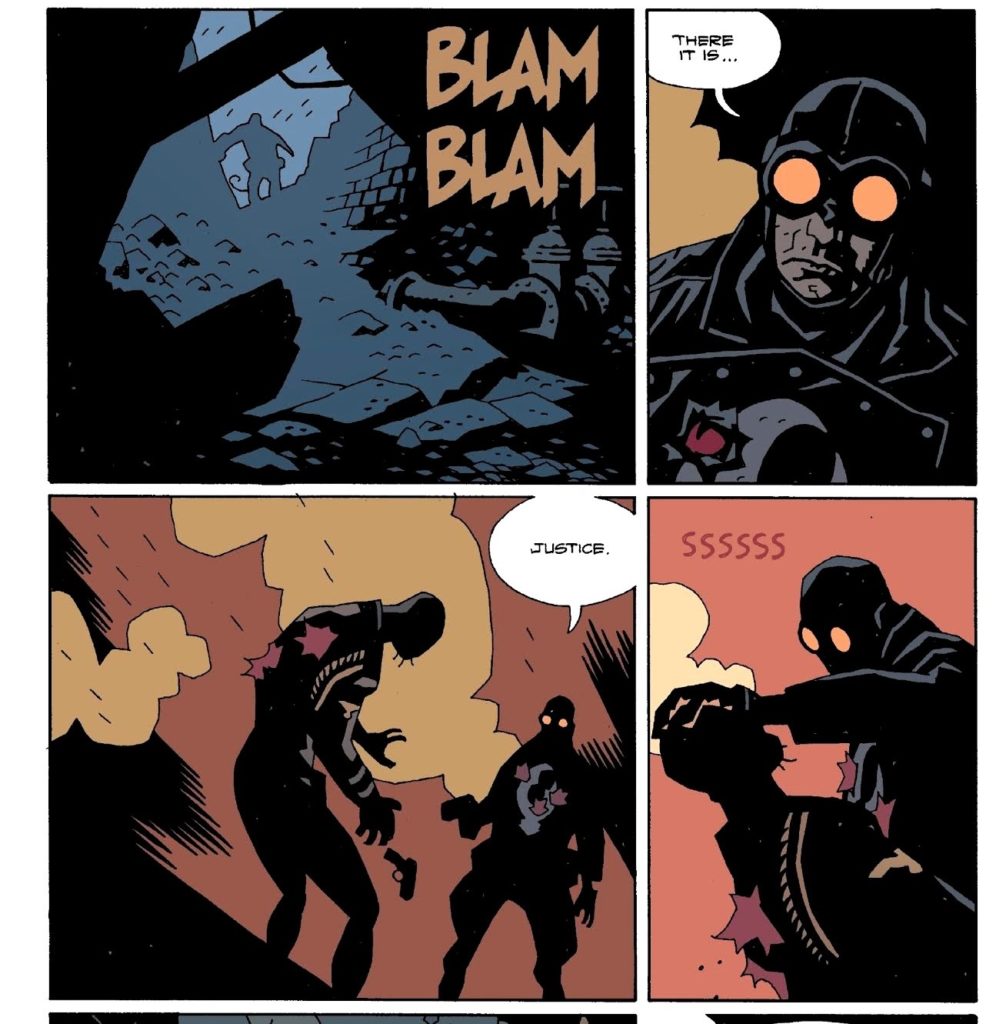There are many ways the world may end. But some endings bring new beginnings.
After 7 years of stories, author Mike Mignola brought Hellboy’s long-running narrative to a boil with Conqueror Worm – a four-issues series that would shut the door on several elements that had been, until this point, inextricable aspects of what makes a Hellboy comic a Hellboy comic. And in doing so, Mignola gave life to a new direction for his half-demon, half-man hero. But first, he had to pay tribute to the bygone stories that inspired the pulp adventure side of his gothic horror franchise.
Conqueror Worm is the culmination of the initial story Mignola had been building since Seed of Destruction in 1994 and serves as the end of the first act of Mignola’s Hellboy epic, honoring the roots of the character before pushing into a new era.
Related Reading Orders:
In Conqueror Worm, originally published in 2001, Hellboy and Roger the Homonculus, a powerful man-made humanoid who first debuted in Wake the Devil and was given greater depth in Almost Colossus, come to the site of a World War II Nazi experiment. It’s here at Hunte Castle in Austria that a Nazi rocket returns from space and brings with it one of the Ogdru Hem – a hideous monster spawned from the Ogdru Jahad dragon. Only Hellboy, Roger, and the spirit of Lobster Johnson can stop this slouching beast from consuming the world.
Conqueror Worm is an ode to the pulp heroes of the early 20th century created to fight criminals and Nazis who were supplanted in pop culture by superheroes. Like the gigantic worm brought back from the depths of space, Mignola brings back the Nazis and Rasputin, evil men directly tied to Hellboy’s debut, to permanently say goodbye to them in Hellboy’s central narrative.
As the culmination of Act 1 of Hellboy, Conqueror Worm contains three aspects that make it a critical element of a larger story: the use of pulp fiction in both Hellboy and his supporting heroes, the Lovecraftian inspiration that serves as the permanent destruction of the Nazi threat, and the sendoff Mignola gives to everything he’s built up so far, giving both Hellboy and the BPRD a chance for greater potential.
—-
“God damn nazi-frankenstein monkey! You DON’T know WHEN to QUIT!”
Whu! Whaa! No! Master … Save me.
SHUT UP!”
—-
Previously, we’ve discussed Hellboy as the working man protagonist, the tragic Byronic hero, and the wandering mythic being, but he’s also indebted to the heroes of pulp novels and radio serials.
Said Mignola, “I think that the bigger, fundamental structure of Hellboy came from pulp magazine guys like Robert E. Howard and Manly Wade Wellman. Specifically, the idea of this kind of character who wanders. Also, the short stories that don’t take place in a chronological order.”
But what makes a pulp hero a pulp hero?
A “pulp” magazine was the term used to refer to inexpensive fiction magazines published from 1896, when Frank Munsey’s revamped Argosy magazine debuted, to the late 1950s. The term pulp is in reference to the cheap wood pulp paper these magazines were typically printed on to save money, as compared to the “glossy” or “slick” magazines concurrently published at the time, which used higher quality printing materials.
These cheaply produced pulps printed sensational and lurid stories, becoming successors to the penny dreadfuls and dime novels that dominated most of the 1800s. And while all manner of genres were printed in these magazines, “hero pulps” became some of the most well known and influential products of the era. Alex Raymond’s Flash Gordon explores the sci-fi adventure side of pulp while Walter B. Gibson’s The Shadow stalks crime-ridden streets in pursuit of justice and Ralston, Nanovic, and Dent’s Doc Savage travels the world as an early progenitor of the superman archetype.
Pulp heroes sit in various genres, but they’re all typically non-powered men using their wits and violence to save the day from a dangerous outside force – monsters, aliens, exotic crime – that threatens to disrupt the normal life of average citizens.
The coming of World War II created a shortage of paper material for pulp publishers, forcing them to switch publishing strategies. But really, it was the advent of the comic book and the widespread growth of television that brought the pulp era to a close. Take a look at the comics of the 1950s and you’ll see pulp influence everywhere. While superheroes had exploded in popularity during the 40s, the end of World War II saw heroes majorly decline in popularity. In their place came romance comics, sci-fi comics, horror comics, western comics, crime comics, all more sensational topics meant to capture readers in a way not unlike the pulps.
Of course, the 60s saw the permanent return of superheroes as the dominant force behind comics, but the pulp hero influence can be seen in a lot of different characters. Batman, of course, is the preeminent one, but The Spirit, Adam Strange, The Rocketeer, and V are all direct descendants of pulp fiction.
The very character of Hellboy, given his World War II and occult origin, has a direct link to pulp stories. There’s superhero DNA in the character, of course, but Mignola almost sidesteps decades of comics to return to a darker, more horror-inflected version of heroism. Hellboy’s essential physical characteristics – red skin, horns, giant right hand of doom – are indicative of his supernatural side, but his outfit is pure pulp. Heavy trench coat, belt full of useful tools, giant gun, his shaven horns even evoke goggles like G-8. He’s an agent moving from crime scene to crime scene to investigate threats that no one else is equipped to handle. Remove the doomsday prophecies that Mignola bakes into the character and you have a classic pulp hero using his fists and bullets.
But Mignola’s greatest ode to pulp heroes comes in the form of Lobster Johnson.
Conqueror Worm begins in 1939 as a group of American soldiers invade Hunte Castle in Austria to stop a Nazi rocket launch. They’re aided by a mysterious man with goggles and a claw symbol, but they’re soon all killed in the explosion. When Hellboy and Roger arrive in present day, the spirit of Lobster Johnson awakens, helping them permanently stop the Nazi remnant.
Johnson is most obviously indebted to G-8 in appearance, but marks his targets with a burning claw, much like pulp hero The Spider. He even has film serials made about him. Effectively turning the pulp-inspired hero into an in-universe pulp hero. There’s an inherent ridiculousness to Lobster Johnson, especially in the context of the Mignolaverse. There aren’t any costumed heroes here, and Mignola immediately dismantles the idea of superheroes living to see another day by killing off The Lobster during his introduction.
Like the rest of Conqueror Worm, Lobster Johnson is brought into this story to highlight the roots of Hellboy so that Mignola can lay them to rest.
—-
Out — out are all the lights — out all! And over each quivering form … the curtain, a funeral pall, comes down with the rush of a storm … while the angels, all pallid and wan, uprising, unveiling, affirm … that the play is the tragedy, “man” … and its hero the conqueror worm.
—-
So much of Hellboy’s story revolves around his fate as the Beast of the Apocalypse and his temptation from many different sides to bring about the end of the world. But what Conqueror Worm shows is that there are many ways the world may end, not just with Hellboy as the cause. The inevitability of endings is hinted at by Mignola’s use of Edgar Allen Poe’s Ligeia (Lie-zhee-uh) at the story’s start, giving this story its namesake.
In one of their many grasps at power, the Nazis sent the dead body of a scientist into space so that an Ogdru Hem spirit could possess it and return to grant them power. The interference of Lobster Johnson foiled the original plan, but the rocket still escaped. Now, 61 years later (Hellboy takes place in real time with its comics occurring at the year of their publication), the rocket returns due to the actions of vile head in a jar Herman von Klempt and his granddaughter Inger.
The old regime and the new remnant, both bringing about ruin in their pursuit of power.
The Nazis of Conqueror Worm are trying to capture a power and glory that was never real in the first place. Nazism is based on the deluded belief of superiority and racist inequality that comes from a pitiful grasping at power. In Conqueror Worm, this extends to their attempt at harnessing ancient power for their own gain. The Ogdru Hem are inspired by the works of H.P. Lovecraft, the mind-melting horror counterpart to the pulp heroism that was published at the same time. And like Hellboy’s heroic inspirations, Lovecraft’s work also began in pulp magazines, with The Call of Cthulu first published in Weird Tales and At the Mountains of Madness printed in Astounding Stories.
Like most pulp stories of the time, Lovecraft’s works weren’t lauded upon publication, but their captivating ideas have seeped into popular culture, influencing hordes of authors while thankfully leaving Lovecraft’s racism behind.
In Lovecraft’s works, cosmic beings like Cthulu drive men mad out of their sheer ungraspable nature. The Ogdru Hem of Mignola’s works also defy explanation, and the Nazi’s deluded belief that they can both understand and control them is what leads to their destruction.
There’s an obvious Lovecraftian inspiration to Mignola’s cosmology, but when combined with the mythologies of many different cultures, the Mignolaverse further defines its own brand of horror.
The Conqueror Worm unleashes a gas that transforms the Nazi remnant into frog men, just like those first seen in the debut arc “Seed of Destruction” and the same that will become the main focus in BPRD: Plague of Frogs. To accompany the creatures, the author brings an alien into the story – the same type of creature glimpsed on a single page in the first ever arc to bring closure to the ideas that accompanied Hellboy’s debut.
The worm cannot be stopped by bombs or guns or fists. Only Roger, possibly the most tragic character in the entire Mignolaverse, has the power to defeat the Ogdru Hem.
—-
“I am the FUTURE!”
“You owe too much to the past … you have to pay.”
Bap bap bap
BLAM BLAM
There it is … Justice.”
SSSSSSSS
—-
Conqueror Worm ends with 3 conclusions so that new paths can begin.
Back in 2001, Mignola said, “I realized that this was the wrap up of the Nazis because I’ve dropped all these hints about Hellboy possibly being the Beast of the Apocalypse and I wanted to just go in that direction. I’ve done the mad scientist and Nazis but my interest has been more the supernatural and folklore end of stuff.”
Mignola’s art in Conqueror Worm stands at an interesting crossroads within his larger artistic progression. Almost the entire story takes place within a haunted, burnt out castle, with pitch black shadows filling the backgrounds and crevices of faces. Mignola has leaned far more into the blunted angles that define his work, but he still retains a level of detail that will have greatly lessened by the time of Hellboy in Hell. So Conqueror Worm’s art equally balances what you do and don’t see as dictated by the artist. The worm itself and its transformation of people into frog creatures is shown in detail, letting the reader take in the revelation that the Nazi Inger has been tricked into physically transforming herself while retaining her intelligence. An existentialist bit of body horror that serves as due punishment. The rest is creeping shadows that let small bits of horror reveal themselves to the reader through Dave Stewart’s colors – squirming tentacles, ghostly apparitions, and aliens. It’s classic gothic Mignola saying farewell to the steampunk terrors that brought his hero to life.
With all other forms of defeating the worm destroyed, Roger is able to suck the Ogdru Hem’s essence into himself to contain it. Prior to the mission, BPRD chief Tom Manning had given Hellboy the detonator to a bomb planted within Roger should the homunculus lose control. It’s in this moment that Hellboy must decide if sacrificing Roger is acceptable if it means killing the worm.
It’s one of the few major moral crossroads faced by the hero this far in the series and proves that both Hellboy and Roger are more human than what people like Manning believe. Refusing to use the detonator, Roger is saved by the timely intervention of Lobster Johnson and a lightning rod, destroying the worm and finally setting The Lobster’s spirit free.
With the worm gone and the Nazis defeated, Hellboy quits the BPRD to explore the world.
“You just take care of yourself.” “You bet.”
All of these events are seen by Rasputin, now a ghostly apparition hoping that his vision for the end of the world will still come to pass despite being killed by Hellboy. But in Conqueror Worm’s epilogue, the ongoing scheme of Rasputin is supplanted by the prophecy of Hecate – the Greek goddess introduced in Wake the Devil. Rasputin gave Hecate the power to rise after her defeat by Hellboy and now, with her destruction of Rasputin, Hellboy’s journey is defined by a seemingly inevitable role in the end of the world with her.
Nazis, Rasputin, pulp heroism, and cosmic horror are gone, and the fate of all of creation has taken their place.
In typical Mignola fashion, everything the author thought he’d said goodbye to would return in a later story. The Nazis and Rasputin played pivotal roles in the endgame of The Devil You Know, Lobster Johnson’s restless spirit would rise again, and Hellboy’s time with the BPRD is now being explored in a prequel series. What makes the Mignolaverse a consistently fascinating piece of literature is that the author and his co-creators are both continually adding new elements while never able to fully let go of the captivating ideas they introduced decades ago.
But the end of Conqueror Worm makes two new diverging stories now possible – the spin-off BPRD comic, written by John Arcudi, Mike Mignola, and several others, and the continuing travels of Hellboy, with The Third Wish and The Island marking a major period of change
It’s only fitting that most present day-set stories after Conqueror Worm ditch the gun and have Hellboy use his fists or a sword. The pulp aesthetics have been removed along with the pulp storylines to better transition Hellboy into an ancient mythological world.
Meanwhile, those pulp aesthetics transition into further doomed Lovecraftian horrors in B.P.R.D. Instead of Hellboy, characters like Roger, Abe Sapien, Kate Corrigan, Liz Sherman, and Johann Kraus must contend with a rapidly expanding threat explored in larger story cycles. In both of these branching stories, Mignola and collaborators explore the pressing weight of having your own life and the fate of the world seemingly pre-ordained.
The world of Hellboy is consumed by darkness, and within these shadows lurks ancient evil waiting to consume the living. But there’s also hope. A hope for freedom from the past evils of man and for a new world unchained from our past sins. And whether it’s against the worst of mankind or terrors beyond comprehension, Hellboy and the BPRD will fight for that hope.
Sources:
- https://www.cbr.com/mike-mignola-interview/ –
- https://www.darkhorse.com/Interviews/763/Mike-Mignola –
- https://13thdimension.com/hellboy-week-mike-mignola-talks-literary-and-pulp-influences/
For More From Matt Draper:
The post The Pulp Horror and Heroism of Hellboy: Conqueror Worm appeared first on Comic Book Herald.



